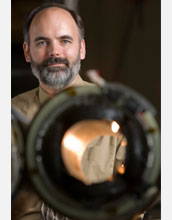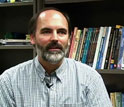News Release 08-078
Designer Isotopes Push the Frontier of Science
Applications include medicine and national security

Bradley Sherrill, distinguished professor at Michigan State University.
May 9, 2008
This material is available primarily for archival purposes. Telephone numbers or other contact information may be out of date; please see current contact information at media contacts.
Designer labels have a lot of cachet, a principle that's equally true in fashion and physics.
The future of nuclear physics is in designer isotopes--the relatively new power scientists have to make specific rare isotopes to solve scientific problems and open doors to new technologies, according to Bradley Sherrill, a University distinguished professor of physics and associate director for research at the National Superconducting Cyclotron Laboratory (NSCL) at Michigan State University (MSU).
"We have developed a remarkable capability over the last 10 or so years that allows us to build a specific isotope to use in research," Sherrill said. "It is a new tool that promises to allow whole new directions in research to move forward. There are tremendous advances that are possible."
Sherrill outlined some of the possibilities and what it will take to get there in a perspective piece in the May 9 edition of Science magazine.
In that article, he writes nanotechnology is getting a lot of attention for the astonishing possibilities of constructing objects with individual atoms and molecules. Sherrill, however, said that nanotechnology hardly is the last word in small.
The chemical changes that brought about the formation of the elements in the bellies of stars are being recreated in laboratories such as MSU's NSCL. Advances in basic nuclear science already have given way to technologies such as PET (short for positron emission tomography) scans, which are medical procedures that use special isotopes to target specific types of tumors.
Isotopes are the different versions of an element. Their nuclei have different numbers of neutrons, and thus give them different properties. Rare isotopes don't always exist in nature. They must be coaxed out with high-energy collisions created by special machines, like those in MSU's Coupled Cyclotron facility. As technology advances, newer equipment is needed.
The next step for the U.S. nuclear science community will be the Facility for Rare Isotope Beams, a world-leading facility for the study of nuclear structure and nuclear astrophysics, expected to be built by the U.S. Department of Energy sometime in the next decade. Through his involvement on various national committees, Sherrill has long been a champion of a next-generation facility to ensure U.S. competitiveness in rare isotope research and nuclear science education.
Sherrill said that science to examine the core nature of the elements of life holds its own gold mine of potential. He offers up PET scans as an example of the payoff associated with pushing the bounds of accelerator science to study new specific isotopes. To create PET scans, scientists first had to create an isotope with a specific radioactivity that decayed quickly enough and safely enough to inject in the body.
"The rare-isotope research supported by National Science Foundation (NSF) at the NSCL enables us to push forward our understanding of nuclei at the frontiers of stability, with direct connections to the processes that produce the elements in our world and that underlie the life cycle of stars," said Bradley Keister, a program officer in NSF's Physics Division. "Applications to societal areas including medicine and security have traditionally gone hand in hand with these ever-advancing capabilities."
In the Science piece, Sherrill said that aggressively pursuing rare isotope research is a national imperative.
"These are isotopes that are not easy to produce. That's the frontier we're working on," Sherrill writes. "A wider range of available isotopes should benefit the fields of biomedicine (by producing an expanded portfolio of radioisotopes), international security (by providing the technical underpinning to nuclear forensics specialists) and nuclear energy (by leading to better understanding of the sort of nuclear reactions that will power cleaner, next-generation reactors)."
-NSF-
-
View Video
MSU Professor Brad Sherrill discusses the benefits of a powerful new "atom smasher."
Credit and Larger Version
Media Contacts
Diane Banegas, National Science Foundation, (703) 292-4489, email: dbangeas@nsf.gov
Geoff Koch, Michigan State University, (703) 292-4489, email: koch@nscl.msu.edu
Program Contacts
Bradley Keister, National Science Foundation, (703) 292-4489, email: bkeister@nsf.gov
Principal Investigators
Brad Sherrill, Michigan State University, (517) 333-6322, email: sherrill@nscl.msu.edu
Related Websites
Article on rare isotope research by co-written by Brad Sherrill.: http://cerncourier.com/cws/article/cern/29866
The U.S. National Science Foundation propels the nation forward by advancing fundamental research in all fields of science and engineering. NSF supports research and people by providing facilities, instruments and funding to support their ingenuity and sustain the U.S. as a global leader in research and innovation. With a fiscal year 2023 budget of $9.5 billion, NSF funds reach all 50 states through grants to nearly 2,000 colleges, universities and institutions. Each year, NSF receives more than 40,000 competitive proposals and makes about 11,000 new awards. Those awards include support for cooperative research with industry, Arctic and Antarctic research and operations, and U.S. participation in international scientific efforts.
Connect with us online
NSF website: nsf.gov
NSF News: nsf.gov/news
For News Media: nsf.gov/news/newsroom
Statistics: nsf.gov/statistics/
Awards database: nsf.gov/awardsearch/
Follow us on social
Twitter: twitter.com/NSF
Facebook: facebook.com/US.NSF
Instagram: instagram.com/nsfgov



